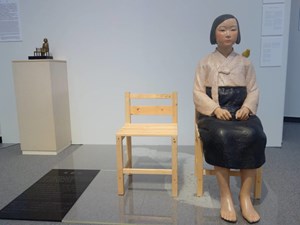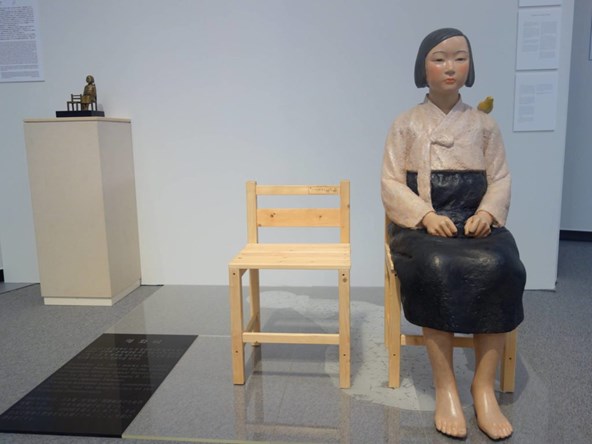
On August 13th, a dozen artists demanded that their work be removed if these conditions are not met. Following discussions between the Aichi Triennale Organizing Committee and individual artists who requested for their works to be withdrawn, the Triennale implemented these requests and certain exhibits were removed as of August 20th.
Image: Kim Seo-kyung and Kim Eun-sung, Statue of a Girl of Peace (2011). Courtesy of the artists.
What happened
The Aichi Triennial, named after the Japanese Aichi prefecture and located in its capital Nagoya, was founded in 2010. Its stated objectives are to demonstrate trends in cutting edge contemporary art centered around visual art with an international perspective, to incorporate performing arts and to enhance the attractiveness of the city and the region through cultural activities.
The 4th edition of the Aichi Triennale saw the inclusion of an exhibition titled After ‘Freedom of Expression?’, which was part of the contemporary art showcase. The exhibition was an expansion of the original exhibition Freedom of Expression? held in Tokyo in 2015.

Kim Seo-kyung and Kim Eun-sung, Statue of a Girl of Peace (2011). Courtesy of the artists.
The Triennial announced it would be showing works that for the most part ‘[for] one reason or another, due to censorship or self-censorship, [...] were not exhibited in the past in Japan.’ The exhibition displayed works that had been rejected or removed from public institutions in Japan because of systematic censorship or fear of controversy due to their depiction of delicate subjects such as the emperor or the Japanese army. Information concerning the circumstances of their removal was displayed alongside the works.
While the first edition in Tokyo did not attract a public outcry, partly because it was only shown in a small private gallery for a short time, the situation at the Triennale was very different. The focus was on a sculpture titled Statue of Peace, depicting a so-called ‘comfort woman’. The ‘comfort women’, Korean women forced by the Japanese occupiers to serve as prostitutes for the Japanese soldiers, have been a highly sensitive issue in the relations between Korea and Japan since the second world war, and remain so especially after current prime minister Shinzo Abe had the courage to address the issue in 2015.
The Triennale opened to the public on August 1st. The exhibition After ‘Freedom of Expression?’ was on display in the Aichi Prefectural Museum of Art Gallery, the main venue of the Aichi Triennale, but was closed on August 3rd following many aggressive phone calls, one anonymous handwritten fax threatening arson and a call by the Nagoya mayor Takashi Kawamura ‘to remove the Statue of Peace and cancel "After 'Freedom of Expression?”
The fax was deemed relevant after last month’s arson attack on an animation studio in Kyoto that killed 35 people. A suspect has since been arrested.
The Triennale claimed that the decision of its Organizing Committee to close the exhibition was a measure to ensure a safe and secure setting for visitors and was not an act of censorship.
On August 3rd, two Korean artists participating in the Triennale asked for their works to be withdrawn.
On August 6th, 72 of the 90 artists participating in the Triennale published a statement about the case. That statement has now been signed by 87 of the 90 participating artists. It provides a balanced view of the situation, makes a case for the importance of art and seeks ‘a discussion that is open to all people and respects individual opinions and viewpoints and a Triennale that is capable of realizing such a discussion’.
The artists requested three things: the immediate restoration of the Aichi Triennale 2019’s autonomy from political pressure and intimidation; the continuation of the exhibition under the assurance of safety for all its staff and visitors; and the establishment of a platform for free and vigorous discussion that is open to all, including the participating artists.
On August 13th, a dozen artists demanded that their work be removed if these conditions are not met. Following discussions between the Aichi Triennale Organizing Committee and individual artists who requested for their works to be withdrawn, the Triennale implemented these requests and certain exhibits were removed as of August 20th.
Statement
On August 13th, a dozen artists demanded that their work be removed if these conditions are not met. Following discussions between the Aichi Triennale Organizing Committee and individual artists who requested for their works to be withdrawn, the Triennale implemented these requests and certain exhibits were removed as of August 20th.

ArtDependence Magazine is an international magazine covering all spheres of contemporary art, as well as modern and classical art.
ArtDependence features the latest art news, highlighting interviews with today’s most influential artists, galleries, curators, collectors, fair directors and individuals at the axis of the arts.
The magazine also covers series of articles and reviews on critical art events, new publications and other foremost happenings in the art world.
If you would like to submit events or editorial content to ArtDependence Magazine, please feel free to reach the magazine via the contact page.